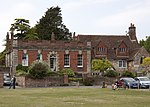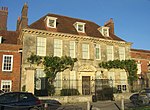The Salisbury Museum

The Salisbury Museum (previously The Salisbury and South Wiltshire Museum) is a museum in Salisbury, Wiltshire, England. It houses one of the best collections relating to Stonehenge and local archaeology.The museum is housed in The King's House, a Grade I listed building, where King James I of England was entertained in 1610 and 1613. Set in the surroundings of the Cathedral Close, the museum faces the west front of Salisbury Cathedral. Previously at 40-42 St Ann Street, where it had been founded in 1860 by Dr Richard Fowler, FRS, it transferred to its current site in 1981.The original three-storey building, with mullioned and transomed windows, ornate plaster ceilings and a fine oak-balustraded staircase, houses the main temporary exhibition gallery with the ceramics gallery above. The arms of James I's eldest son, Henry Frederick, Prince of Wales, can be seen in a window in the Wedgwood gallery upstairs. The director of the museum is Adrian Green. He is supported by chief operatng officer Lucy Bridal.
Excerpt from the Wikipedia article The Salisbury Museum (License: CC BY-SA 3.0, Authors, Images).The Salisbury Museum
West Walk, Salisbury Harnham
Geographical coordinates (GPS) Address External links Nearby Places Show on map
Geographical coordinates (GPS)
| Latitude | Longitude |
|---|---|
| N 51.0645 ° | E -1.8001 ° |
Address
Salisbury and South Wiltshire Museum (Salisbury Museum)
West Walk 65
SP1 2EZ Salisbury, Harnham
England, United Kingdom
Open on Google Maps










